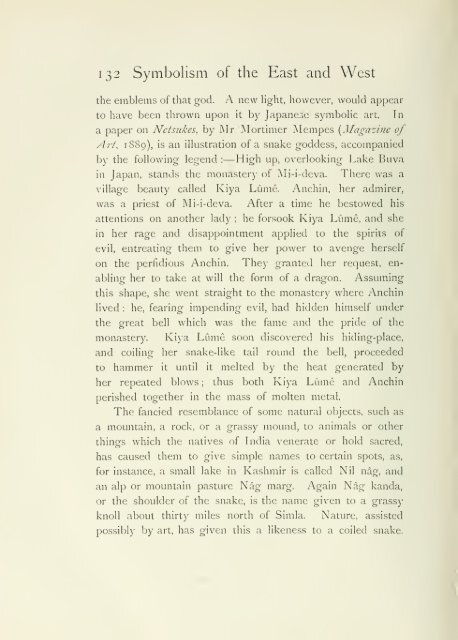Download Ebook - Free History Ebooks
Download Ebook - Free History Ebooks
Download Ebook - Free History Ebooks
Create successful ePaper yourself
Turn your PDF publications into a flip-book with our unique Google optimized e-Paper software.
132 Symbolism of the East and West<br />
the emblems of that god. A new light, however, would appear<br />
to have been thrown upon it by Japanese symbolic art. In<br />
a paper on Netsukes, by Mr Mortimer Mempes [Magazine of<br />
Art. 1889), is an illustration of a snake goddess, accompanied<br />
by the following legend :— High up, overlooking Lake Buva<br />
in Japan, stands the monastery of Mi-i-deva. There was a<br />
village beauty called Kiya Lume. Anchin, her admirer,<br />
was a priest of Mi-i-deva. After a time he bestowed his<br />
attentions on another lady ;<br />
he<br />
forsook Kiya Lume, and she<br />
in her rage and disappointment applied to the spirits of<br />
evil, entreating them to give her power to avenge herself<br />
on the perfidious Anchin. They granted her request, en-<br />
abling her to take at will the form of a dragon. Assuming<br />
this shape, she went straight to the monastery where Anchin<br />
lived : he, fearing impending evil, had hidden himself under<br />
the great bell which was the fame and the pride of the<br />
monastery. Kiya Lume soon discovered his hiding-place,<br />
and coiling her snake-like tail round the bell, proceeded<br />
to hammer it until it melted by the heat generated by<br />
her repeated blows ;<br />
thus<br />
both Kiya Lume and Anchin<br />
perished together in the mass of molten metal.<br />
The fancied resemblance of some natural objects, such as<br />
a mountain, a rock, or a grassy mound, to animals or other<br />
things which the natives of India venerate or hold sacred,<br />
has caused them to give simple names to certain spots, as,<br />
for instance, a small lake in Kashmir is called Nil nag, and<br />
an alp or mountain pasture Nag marg. Again Nag kanda,<br />
or the shoulder of the snake, is the name given to a grassy<br />
knoll about thirty miles north of Simla. Nature, assisted<br />
possibly by art, has given this a likeness to a coiled snake.

















